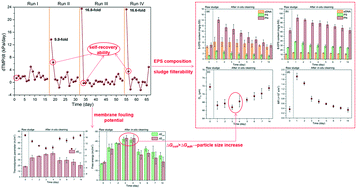Effects of NaClO shock on MBR performance under continuous operating conditions
Abstract
In situ chemical cleaning with sodium hypochlorite (NaClO) is frequently employed to maintain a constant permeability in membrane bioreactor (MBR) systems. In this study, the effects of NaClO shock on MBR performance under continuous operating conditions were investigated. A lab-scale MBR was operated for three runs with in situ chemical cleaning. Experimental results demonstrate an obvious increase of the membrane fouling rate (13.7, 23.5 and 23.3 kPa d−1) on day 1 of cleaning, followed by a rapid reduction (6.4, −0.2 and 3.5 kPa d−1) on day 2 of cleaning. This indicates the rapid self-recovery ability of the NaClO-shocked sludge. Furthermore, as the operating time increased, the sludge extracellular polymeric substance (EPS) content initially increased, followed by a subsequent decrease, with the gradual improvement of sludge filterability that consequently reduced membrane fouling. Thermodynamic analysis revealed that the shocked-sludge surface properties, including the surface electron donor component (γ−), hydrophobicity, adhesive energy and self-cohesive ability, were gradually restored to the raw sludge level, which reduced the membrane fouling potential.

- This article is part of the themed collection: Best Papers 2021 - Environmental Science: Water Research & Technology


 Please wait while we load your content...
Please wait while we load your content...